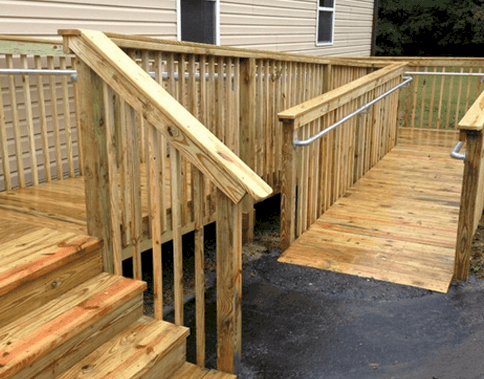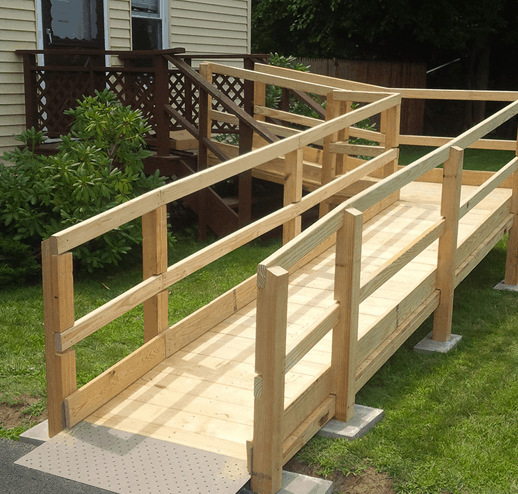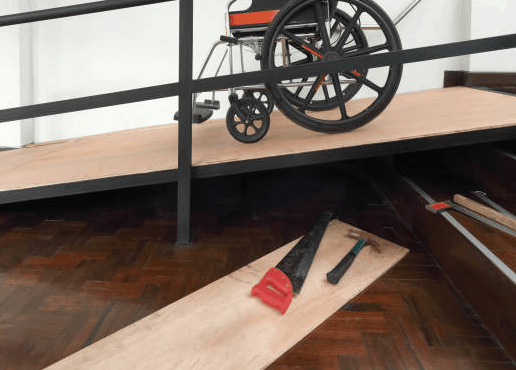Wood Wheelchair Ramp
Looking to build a temporary wood wheelchair ramp?
We offer custom-built, attractive, and affordable wood ramps for residential use.
The home can sometimes be a difficult place to navigate for people with mobility challenges. Did you know that there are about 2.7 million wheelchair users in the U.S. who rely on safe mobility solutions? This is where wheelchair ramps come in as among the most common examples of home accessibility solutions. Access ramps enable wheelchair-bound individuals and elderly people to move about their homes freely and safely. These handicapped ramps offer users safety and security. The construction of wheelchair ramps is a practical and affordable solution to enhance mobility. Scooter and wheelchair users can access steps, doorways, sliding glass doors, showers, or even raised landings easily when there are ramps provided for them. There are many factors to consider when evaluating your home for wheelchair accessibility with a ramp. These include the location of ramp installation and the type of material that should be used. There are many types of ramps available, and depending on the individual’s needs, the best solution will vary.
How much does a wooden wheelchair ramp cost?
Many homeowners install ramps inside and outside their homes especially when they have an elderly family member who has difficulty moving around the house. Let’s say you or a family member needs a wheelchair ramp at home for greater mobility and comfort. You have numerous choices and pricing options to choose from, and costs are affected by materials, design, and location. The national average costs range to install a timber wheelchair ramp is from $1,400 to $3,000. Around $2,500 is typically charged to homeowners to install a 20-foot wood ramp. For comparison purposes, a prefabricated doorway ramp’s price can be less than $50. While a permanent concrete ramp with handrails may have a price of up to $6,000.

Plan and design of a timber ramp
n general, most building owners prefer a fixed cement type of ramp or a temporary wheelchair ramp made from pressure-treated timber. Wheelchair ramps offer an easy and safe way of navigation for wheelchaired people to move in and out of the house easily. They also provide access to equipment and products in trolleys and scooters. It is recommended to install permanent wheelchair ramps only where there is a fixed entrance to the house to enter in a wheelchair. For example, some ramps are specially designed to span, which varies in designs according to the height the wheelchair has to traverse vertically. Generally, a straight and slightly inclined accessibility ramp is the most effective solution to cover a short distance safely if the building has only a few steps. If you need to cover a greater distance in a wheelchair, creating a wheelchair ramp is the best solution especially when the stairs are steep. A wheelchair ramp is a specially designed slope used for making it easier for wheeled chairs and any other equipment that is being moved around a house or building. Other options include Baltimore stairlifts

How do you make a wooden wheelchair ramp?
The use of wooden ramps has been the norm in residential handicap ramp applications for a long time. A wood wheelchair type of ramp is usually made from pressure-treated timber. Here’s why a wooden access ramp is a practical accessibility solution to your home:
- Construction of wood ramps is usually carried out on-site, incorporating angles and bends into the ramp design as necessary. The ramp can be customized, making it more appropriate and tailored to fit specific needs.
- They have a variety of features that make them sturdy and durable which can accommodate even heavy scooters to get in and out of the building with ease.

How to Build a Wheelchair Ramp from Wood
There are many tutorials for DIY projects on the internet that you can pattern to build your own wooden ramp. You should take extra precautions, as this is not a building project for a beginner. Since the well-being of everyone who uses the ramp is at stake, the ramp must be constructed of the best materials and in accordance with local building codes and specifications.
Some articles that will guide you to plan for a proper design,and build a good timber handicap ramp are Wood Ramp Design and Construction Manual and Wood Ramp Design – NC State University
It is important to follow safety regulations according to The Americans with Disabilities Act (ADA). It specifies ramp design rules for public buildings where a ramp needs to be 12 inches long for each inch of vertical rise. Even though this rule does not specifically apply to residential construction, many local communities may still enforce adherence to this standard. Also, the ADA requires platform deck at door level that measure at least 5’ x 5’ in size. You should have timber ramps built with each side’s handrail to make it safer and for extra support. You can use non-skid paints and non-slip tapes for added surface traction on your wooden ramp.
Where to best install a handicap ramp
To determine the best location to install a ramp, the first spot to consider is the entrance to the home. Typically, this is either the front or back door; however, in the case of a home with an attached garage, the access door to the garage may be the best option. In general, there are a few standard rules that apply – the length of the ramp depends on the difference in height between the inside floor level and the grade level at the sidewalk or garage floor. The steepness of the ramp plays a crucial role in allowing wheelchair users to safely enter and exit their homes. If you need a well-planned and personalized accessible ramp for your homes, don’t hesitate to call us. We’d be glad to help build customized ramps for your needs.
Who can build a wheelchair ramp for free?
Many organizations throughout the country build ramps for those who can’t afford them. Here is the list of organizations, charitable programs, and institutions that offer both building and funding services. Do not worry if you cannot get approved through Medicaid. You can look for free programs. As an example, Habitat for Humanity provides free handicapped ramps to disabled, low-income, and retired seniors. The program sends someone out to assess your home and to determine your need for the modification. It is constructed by volunteers with materials donated by individuals and organizations. A disabled person or a low-income senior can receive Medicaid waivers to pay for home modifications. You need to apply for a home modification waiver from your state. Every state has its own set of requirements.
Who can build a wheelchair ramp for free?
The cost of wheelchair ramps is usually not covered by traditional Medicare plans. Its policies do not cover residential modifications and equipment upgrades. The reason is that ramps for wheelchairs are covered by Medicare’s Durable Medical Equipment policy, which requires a physician to declare the ramp a medical necessity. However, some seniors have better luck with newer plans like Medicare Advantage to help them with the construction of a ramp. Many plans include supplemental benefits like health care items that prevent injury, limit emergency room visits, or assist with practical functions.
Who may qualify for Medicare Advantage Programs?
People who suffer from:
- metastatic cancer,
- rheumatoid arthritis,
- Alzheimer’s disease,
- and other forms of dementia and memory loss
They may be eligible for Medicare Advantage benefits that may cover home wheelchair ramps and other upgrades.
Medicaid Assistance
Medicaid ramps are an option for retired seniors and elderly with low income, and persons affected by a handicap. Every state may have its own Medicaid policies, but there are regular benefits as well as long-term nursing home care benefits. Waivers are also available through Home and Community-Based Services (HCBS). As Medicaid is an entitlement program, it typically only covers wheelchair ramps that are necessary because of medical care. Several successful cases have required going through court, but this case is highly unusual. Thankfully, many states offer HCBS waivers to make home modifications and handicap ramps.
